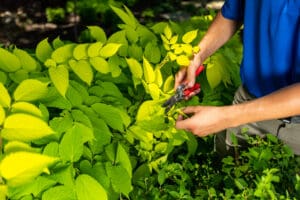Just as the name suggests, lawn aeration involves the allowance of air to penetrate the soil beneath your lawn. It might sound strange, but just like all other living things, the grass in your yard needs to breathe to survive (so to speak).
How does grass breathe? At High Prairie Outdoors, we receive questions about this all the time, and we’re always happy to help our friends and neighbors, here in Kansas, better understand the inner workings of your lawn and garden. The answer is C02. Grass, like other green plants, breathes in carbon dioxide, through the air, and through the soil beneath it. This is why it is crucial that grass has access to both air and soil to thrive. Through photosynthesis, your lawn converts C02 to oxygen, expelling it back into the atmosphere, and creating a greener, healthier planet.
So, how can you help your lawn breathe as a homeowner? The answer is lawn aeration. Here, we will explain a few techniques, and how it will help your lawn look its best.
Why is Aeration Necessary?
Now that we have explained the reason for aeration, you might still be wondering why humans need to do it. Hasn’t grass been around for millennia without our help? Of course, but not in lush green manicured lawns like the ones around Kansas. Over time our lawns get beaten down by rain, foot traffic, and even while mowing. This condenses the earth and makes it difficult for air and water to seep into the plants.
Another reason your lawn needs your help is lawn thatch. Lawn thatch is a buildup of mowed grass, dead grass, dried grass, and any other debris in your yard, which weaves itself into your lawn, making it difficult for the grass to breathe.
Aeration takes care of condensed soil and thatch problems, opening the ground through the introduction of tiny holes. The holes allow the air to flow in and loosen the soil so water can more easily access plant life.
Rake and Aerate
Before you begin the aeration process, it is best to remove any debris and thatch which has built up over time. Rake your yard, and pick up sticks and twigs, ensuring the grass is as free from debris as possible. Next, using the aeration tool of your choice, apply consistent 1-6-inch holes across the lawn. You should also water your lawn the day before you aerate so the soil is soft enough to penetrate.
The tool you use to aerate may vary depending on what is available to you. At High Prairie Landscaping Group, we suggest a proper aeration tool, as they are designed to not only create holes for airflow but pull out small plugs of grass and soil to allow for proper distribution of earth.
Some homeowners opt for spike tools, which still create small holes, but may compact the earth further, as there is no earth being removed in the process, only pushed more closely together.
When Should I Aerate?
In Kansas, we suggest the autumn season, as it allows you to multitask in over-seeding before the winter weather hits. You can aerate in spring and summer as well, but during the winter, the ground becomes quite firm in the frost, making it difficult to aerate, which could damage your tools and your lawn.
Aeration is not a frequent lawn fix, but a maintenance procedure performed every year. Depending on your lawn, you may need to aerate more or less. Some garden experts recommend waiting for signs of trouble before aeration, to avoid overly traumatizing the grass.
When in Doubt Call a Landscaper
Aeration is a process performed so irregularly that many homeowners do not bother purchasing the proper equipment for the task. In these types of landscaping situations, it is best to call in a professional landscaper to get the job done right. Landscaping firms are trained in aeration and can diagnose your lawn, and use the right tools and employ the correct tactics for your grass and soil type.
At High Prairie Outdoors, we offer lawn aeration among our many landscaping services. If you are interested in learning more about aeration, or you feel your lawn is looking a bit rough around the edges and aeration could be the answer, we invite you to contact us. Call 1-816-398-2901 and speak to an experienced landscape professional today.



